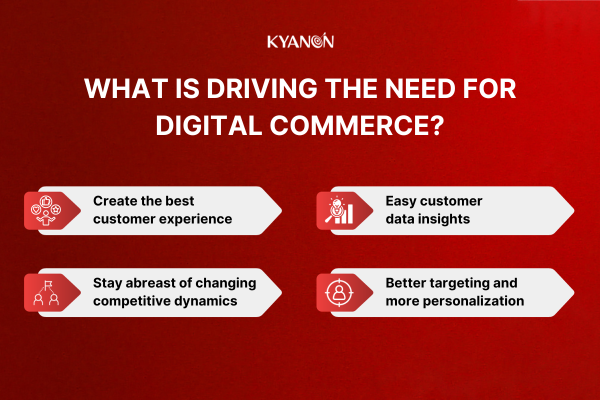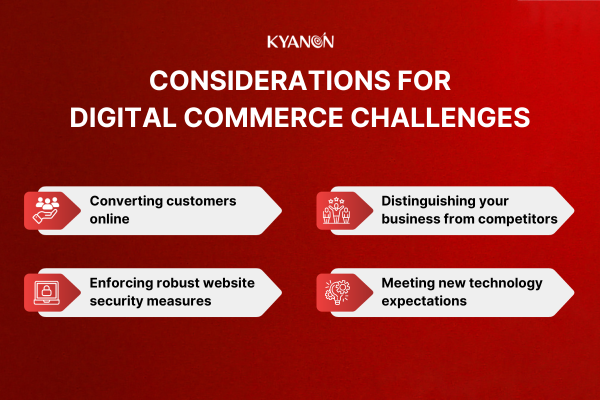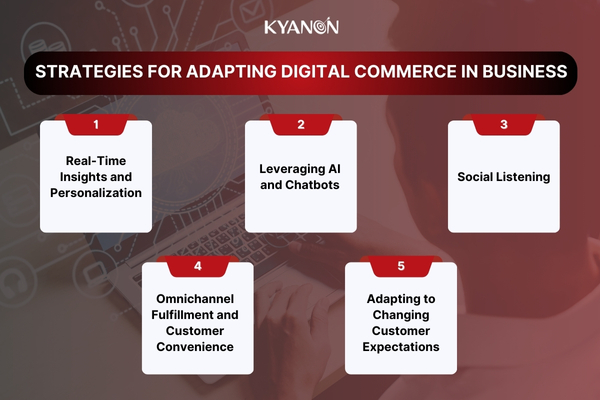What is Digital Commerce? In simple terms, digital commerce—or d-commerce—encompasses every online activity involved in selling products or services, from marketing and payments to delivery and support. Unlike traditional e-commerce, digital commerce covers the entire customer experience across digital touchpoints, empowering businesses to reach a global market with seamless, 24/7 operations.
The growth of digital commerce is reshaping retail by breaking down geographical and time barriers, allowing even small businesses to compete on an international scale. Recent insights reveal that brands leveraging digital commerce can gain valuable data on customer behavior, streamline operations, and increase revenue by keeping up with trends like mobile shopping and voice commerce. As consumer expectations evolve, digital commerce enables businesses to stay agile and competitive in this fast-paced market.
In this blog, Kyanon Digital will guide you through what digital commerce is, how it works, and how it can drive your business forward.
1. What is Digital Commerce?
According to Shopify – a multinational e-commerce company, “Digital commerce is the buying and selling of goods and services conducted electronically over digital platforms. It includes online transactions, electronic payments, and digital marketing strategies to facilitate commercial activities. Digital commerce also includes various forms such as ecommerce including mobile commerce, social commerce, and more.”
2. How does Digital Commerce work?
Digital commerce commences when a customer’s initial online interaction with a brand or product takes place. This initial encounter could occur through various avenues, such as spotting an advertisement in their social media feed, encountering the brand’s website in their Google search results, or perusing a product listing on a retail aggregator.
Take, for instance, a scenario where a customer is browsing Amazon, a prominent e-commerce platform. Amazon utilizes a sophisticated algorithm to customize search results for each individual, ensuring that the order in which items appear can significantly differ from one customer to another. This variability is contingent on numerous factors, including customer behavior history, geographic location, and various other variables.
Every transaction automatically contributes to the refinement of marketing strategies. Analytics play a pivotal role in enhancing the way products are promoted, and displayed on the website, and in the management of customer support and inquiries.
In this context, Digital Commerce transcends the mere process of moving products from one point to another. It primarily revolves around the collection and strategic utilization of customer data to consistently enhance the online shopping experience.
3. What is Driving the Need for Digital Commerce?

3.1. Create the best customer experience
According to a Qualtrics study, over 65% of customers believe that a company’s app or website significantly influences their overall experience. These individuals consider the digital experience a crucial factor when it comes to recommending a brand.
Furthermore, people are increasingly relying on digital platforms for post-purchase support, including customer service. Additionally, the concept of omnichannel fulfillment is gaining prominence, and it has become an expectation for most consumers when interacting with brands today.
In recent years, this trend has evolved into an essential solution for businesses and retailers seeking to boost their sales with minimal effort. This approach streamlines various sales channels, encompassing online, mobile, in-store, kiosk, and call centers, while integrating inventory sources from stores, warehouses, suppliers, and marketplaces. It also offers diverse fulfillment options, such as home delivery, in-store pickup, or collection point pickup.
3.2. Stay abreast of changing competitive dynamics
If you’re not presently engaged in customer journey mapping, it’s highly advisable to initiate the process. It’s likely that your competitors have already integrated this into their digital commerce strategy.
When you concentrate on the key touchpoints in a customer’s journey that foster brand loyalty, you gain insights into what motivates a customer to advocate for your brand among their social circles. Analyzing customer data can streamline the challenge of outperforming your competitors in this regard.
3.3. Easy customer data insights
Digital commerce simplifies the collection and storage of customer data. You gain insights about them seamlessly as they browse or make purchases from your online store.
Even with digital commerce, you can monitor customer interactions and their buying frequency.
Every item that customers view and don’t buy can also assist you in gaining actionable insights related to every customer that can help you organize your whole customer experience.
3.4. Better targeting and more personalization
When you get more and more insightful information from your customers, you will do better at targeting and personalization. Digital commerce can help your business in tracking and purchasing
The more customer insights you get, the better you become at targeting and personalization.
Digital commerce assists in tracking the purchasing habits of every customer and hence helps you gain insights on how to use your promotional campaigns. When it comes to eCommerce, targeting gender, location, and cart abandonment rates becomes easy. Online upselling and cross-selling don’t make the customer uncomfortable or upset as you only offer suggestions for add-ons while purchasing a particular item.
4. Challenges in Digital Commerce
Like any business model, digital commerce comes with challenges, from converting first-time visitors to ensuring website security and adapting to the latest technologies. It’s essential to engage customers with personalized experiences, keep their data safe, and regularly update your strategy to meet their evolving expectations.
To expand on the Challenges in Digital Commerce, here are several detailed points addressing key areas:

4.1. Converting First-Time Visitors
A major challenge in digital commerce is turning one-time visitors into loyal customers. Unlike physical stores, where sales staff can directly engage customers, online stores lack immediate human interaction, which can affect trust and interest.
Effective strategies to tackle this include providing clear and engaging product descriptions, easy-to-use navigation, and user-friendly interfaces. Adding features like live chat, personalized recommendations, and robust return policies can also help convert first-time visitors by building trust and making the shopping experience more intuitive.
4.2. Ensuring Website Security
With digital commerce relying heavily on sensitive customer data, cybersecurity is crucial. Online stores must protect against data breaches, fraud, and unauthorized access to maintain customer trust. According to Statista, cyberattacks on digital businesses are rising, which can lead to significant financial and reputational damage. Businesses need to implement SSL certificates, encryption, two-factor authentication, and regular security audits to safeguard data and prevent malicious attacks.
Example: Amazon and other leading digital platforms utilize advanced encryption and multi-step authentication to enhance security, thus reducing potential risks. Regular software updates and training for employees on cybersecurity best practices are also vital steps in a robust security strategy.
4.3. Keeping Up with Technological Advancements
Digital commerce is fast-evolving, with new tools and technologies emerging constantly, like AI-powered recommendations, chatbots, and augmented reality. To stay competitive, businesses must adopt these technologies and continuously refine their digital strategies. However, implementing and maintaining these advancements requires expertise and often significant investment.
For instance, Shopify and BigCommerce regularly introduce updates and new features to keep pace with market demands and consumer expectations. Investing in training and IT resources can help businesses leverage these tools effectively without falling behind.
4.4. Offering a Personalized Experience
Today’s consumers expect a tailored experience, with relevant product suggestions and targeted content. Personalized experiences are proven to increase engagement and sales, but they require the effective use of customer data. Collecting, analyzing, and using data while maintaining privacy and compliance with regulations like GDPR adds complexity to delivering personalization at scale.
- Solution: Many digital commerce platforms use AI algorithms that analyze purchasing history, browsing behavior, and demographic information to deliver a personalized shopping experience. However, implementing these algorithms can be challenging for small businesses, as they require sophisticated data analysis tools and practices.
4.5. Adapting to Changing Customer Expectations
Consumers today want convenience, speed, and transparency. Meeting these evolving expectations can be challenging as businesses must adapt quickly without compromising quality. Features like one-click checkout, same-day delivery, and real-time customer support are becoming industry standards, yet they require significant operational changes and often higher costs.
4.6. Managing Omnichannel Integration
Digital commerce often extends beyond a single website; it includes mobile apps, social media, and marketplaces. Managing consistent customer experiences across these platforms while keeping inventory synced is challenging but crucial for a cohesive brand experience. An integrated approach to inventory, customer data, and messaging across channels can improve customer satisfaction and streamline operations but requires strong technical infrastructure and coordination.
By addressing these challenges head-on, businesses can build a resilient, competitive digital commerce strategy that’s ready to adapt to market trends and consumer demands.
5. Adapting to Customer Needs in Digital Commerce
Digital commerce isn’t just about making products available online—it’s about delivering a tailored, convenient shopping experience that meets customers’ evolving needs and expectations. This approach requires businesses to be agile, flexible, and deeply informed about customer preferences. So, how do companies achieve this?

5.1. Real-Time Insights and Personalization
One of the most significant advantages of digital commerce is the ability to gather and analyze customer data in real-time. Each interaction, whether it’s a click on an ad or a product view, provides valuable insights into customer interests. By leveraging data analytics and customer relationship management (CRM) systems, businesses can create detailed profiles and respond with personalized recommendations and targeted promotions. Platforms like Shopify and Salesforce offer tools for analyzing purchasing patterns and customer behavior, enabling businesses to refine their marketing strategies dynamically.
5.2. Leveraging AI and Chatbots
Artificial intelligence (AI) and chatbots have become essential in personalizing and enhancing customer experiences. AI can process vast amounts of customer data quickly, identifying patterns and trends that would be hard to spot manually. For example, AI-driven recommendation engines on e-commerce platforms suggest products based on a user’s browsing history, while chatbots provide 24/7 customer support, helping users with everything from product queries to order tracking.
5.3. Social Listening
Social listening allows brands to monitor conversations across social media, giving them insights into customer sentiment and feedback. This information helps companies adjust their messaging, improve products, and engage in meaningful conversations with their customers. Social listening also enables companies to spot trends, respond to complaints quickly, and join popular conversations, creating stronger relationships with customers.
5.4. Omnichannel Fulfillment and Customer Convenience
Consumers now shop across multiple platforms, from websites to social media and mobile apps, and expect a seamless experience. Meeting this expectation requires integrating various channels, ensuring consistent inventory management, and offering flexible fulfillment options like same-day delivery or in-store pickup. Amazon and Walmart have optimized their omnichannel strategies, creating cohesive shopping experiences across digital and physical spaces. This approach not only improves customer satisfaction but also streamlines operations for the business.
5.5. Adapting to Changing Customer Expectations
Customer expectations around convenience, speed, and personalization are constantly shifting. For instance, one-click checkout, speedy delivery, and responsive customer service are increasingly seen as standard. To meet these demands, companies in digital commerce must continuously refine their strategies and explore innovative solutions. Staying agile, monitoring trends, and regularly gathering customer feedback help businesses maintain a competitive edge and exceed customer expectations.
Ultimately, adapting to customer needs in digital commerce is about being proactive, data-driven, and customer-focused. This approach ensures that brands don’t just meet customer expectations but continuously enhance the online shopping experience.
To Wrap Up
Adapting digital commerce in business is no longer just an option; it’s a necessity for staying competitive in the modern marketplace. By leveraging technology and customer data, businesses can create personalized, seamless experiences that meet evolving customer expectations.
From embracing AI and automation to enhancing website security and integrating omnichannel strategies, businesses can overcome challenges and ensure their digital commerce strategies are effective.
Kyanon Digital is a leading consulting and implementation technology company based in Vietnam. Founded in 2012, the company has 10+ years of experience in consulting and software engineering, working with clients across various sectors such as Retail, FMCG, Manufacturing, BFSI, and Logistics. Contact us for more information about Digital Commerce.


